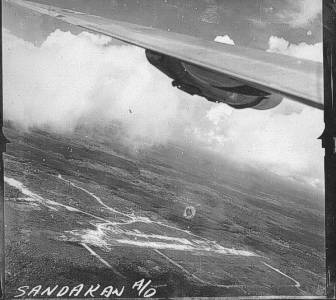It's me at the Sandakan Memorial stone with fresh flowers after the Anzac Day for the memorial ceremony.
That's us, picnic near the pond in the Sandakan Memorial park
From left; Iza, Aunt Ola, me, Mom, Lola and Kak Tasha
Inside the memorial museum - from left; Fizul, Aunt Ola, Iza , Kak Tasha and me.
With Australian tourists; they are all nice!
That's Uncle Eden, with Malaysian, Australian, Britain and New Zealand's flag
Things that you can see in the park
We went to picnic last Sunday at Sandakan War Memorial Park and what ashamed was; we all didn't know that we missed the Anzac Day ceremony on the early of the day! Geez, if only we come early, we can see the whole ceremony.
It's a great place to visit especial for Australian. Here is some cool stuff you have to read about this park;
-----
AUSTRALIA (commonly known as the ANZAC forces from their role with New Zealand during the First World War) played a significant role in Borneo during the Second World War. Sandakan was the place where the many Australians spent time in a prisoner of war camp, and was the starting point for the infamous death marches to Ranau.
After the fall of Singapore and Borneo to the Japanese, a prisoner of war camp was established just outside of Sandakan to house approximately 750 British and more than 1650 Australian prisoners who were sent to the camp during the period 1942-43. In 1945, when the Japanese started to realise that the war may have been lost, and the Allies were closing in, the emaciated prisoners were force marched, in three separate marches, to the village of Ranau in the jungle, 250 km away, under the shadows of Mount Kinabalu. On 28 January, 1945, 470 prisoners set off, with only 313 arriving in Ranau. On the second march, 570 started from Sandakan, but only 118 reached Ranau. The third march which comprised the last of the prisoners from the Sandakan camp contained 537 prisoners. Prisoners who were unable to walk were shot. The march route was through virgin jungle infested with crocodiles, snakes and wild pigs, and some of the prisoners had no boots. Rations were less than minimal. The march took nearly a year to complete.
Once the surviving prisoners arrived in Ranau, they were put to work carrying 20 kg sacks of flour over very hilly terrain to Paginatan, over 40 km away. By the end of July, 1945, there were no prisoners left in Ranau.
Only six Australians of the 2400 prisoners survived the "death march" - they survived because they were able to escape from the camp at Ranau, or escaped during the march from Sandakan. No British prisoners survived.
This part of the war is considered by many to be the worst atrocity ever suffered by Australian soldiers, and compares to the atrocities of the Burma Railway, where fewer Australian POW's lost their lives.
Those that survived the ordeal of the march, did so only because they escaped into the jungle where they were cared for by local natives.
An Australian Memorial honouring the survivors, POW's, local civilians who help to clandestinely feed the prisoners, and soldiers who perished at Sandakan and during the death marches into the jungle, has been erected at what was the Prisoner of War Camp in Taman Rimba close to the city of Sandakan. There are just a couple of rusting bits of machinery around, and the place has an eerie air about it.
The Sandakan Prisoner of war camp has now been transformed into a very beautiful park with a pavilion on site which houses the history of this very tragic period.
Click here to visit the official site of Sandakan War Memorial Park
This story is really touching. Thousand words I cannot share here...















No comments:
Post a Comment